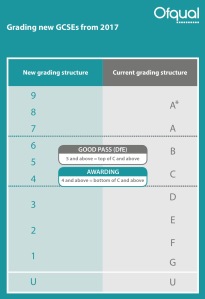- There will be no UMS. These were for modular exams. Everything is now linear.
- The DfE have published descriptors for 2/5/8, however they are mainly meaningless because:
- It will depend exactly on your board for the actual criteria that will be used for your specification
- Exam boards will not use these to allocate grades
- Grade allocations are based on numbers of students NOT these descriptors.
- What a 2/5/8 will change every year depending on the cohort and the teaching. As teachers get used to the new courses, they will get better at teaching them. This doesn’t mean more students will do better.
- Essentially your students are in competition with each other and with every other students sitting that paper. All students cannot achieve a 9.
- You will not get any grade boundaries from anywhere until a set of results has been published. It is no-ones responsibility/fault to do so. They are only ever generated after a session, you’re just used to lots of previous sessions with their boundaries. Make them up if you’re desperate but you’ll 99% be wrong.
- You cannot use the way the DfE/boards will calculate grade boundaries to work out in-house boundaries. They use numbers of students you will use quality of work against a mark scheme. They’re two very different things.

6. You cannot use old spec grade boundaries to calculate new. RS GCSE is a great example. Last year for Edexcel a students needed 96% for an A* and OCR needed 82%. This is % of marks. Again, Ofqual documents reference % of candidates NOT marks. You could use the number of entries data but that won’t help you in-house as you don’t teach the entire cohort of entries.
7. A ‘good’ GCSE and a level 2 pass will be two different things. A 5 is a good GCSE. A 4 is a level 2 pass.u


Essentially my advice is to teach students what they need for the specification you’re doing (and beyond) and teach to the top. Each specification has sample assessment material. Use the levelling/marks and support all students to full marks. Any SLT that thinks you can create any boundaries or descriptors yourself are deluded and are best pacified with something they can enter onto their spreadsheet. They’ll get a shock in 2018…..
References
1-9 grade descriptors for all subjects
https://www.gov.uk/government/publications/grade-descriptors-for-gcses-graded-9-to-1
Current grading vs new grading
Click to access Postcard_-_Grading_New_GCSEs.pdf
set of postcards going through some basics
Ofqual blog
This is all to the best of my knowedge and for classroom teachers, not data managers.
Excellent take on the changes. No. B. NO EXAM BOARD APPEALS.
Pingback: Assessment in RE (part 3) – themyopictortoise
Reblogged this on the unconscious curriculum and commented:
Excellent summary of the omnishambles that is curriculum reform. Makes next years progress data even more meaningless than usual. Good work missdcox!
Dawn, have Ofqual published the actual numbers or percentages of students they will assign to each grade, do you know? If we have these, then we can predict students’ grades by aggregating national low-stakes assessment data on-the-fly.
Low stakes also means low reliability so those predictions wouldn’t be useful. You’d be better off just using your professional judgement.
Reblogged this on The Echo Chamber.
Pingback: Are you brave enough to ditch data? The battle of Data, Ofsted and Research | missdcoxblog
Pingback: A brief guide to the new GCSE grade boundaries | Mr Lyons Maths
Reblogged this on Mr Lyons Maths.
And how do we give colleges predicted grades for post 16? I am tired of people saying “You can’t do anything that will be perfect so don’t try”. We can make assumptions and make predictions based on them. As long as we are clear on the assumptions and their likely impact on predictions then this is better than holding our hands up and saying “Sorry, can’t help you today”. My blog lays out some of this here: http://educatingmrmattock.blogspot.co.uk/2016/11/new-gcse-grade-boundaries-my-thoughts.html?m=1
Pingback: What do you mean, mean scores? | The Stable Oyster